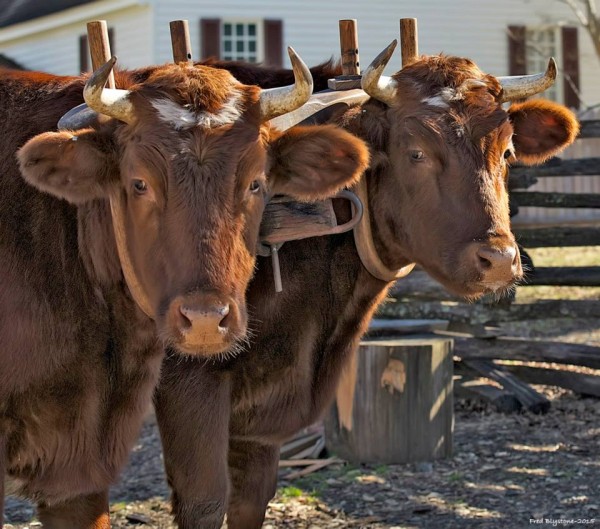 Pat & Mike are the newest additions to our Rare Breeds Program and they earned their title in more ways than one. Only one in every 200 cattle births results in twins! We learned how to tell them apart, what work they’re busy completing in the Historic Area, and why they can’t be called oxen just yet.
Pat & Mike are the newest additions to our Rare Breeds Program and they earned their title in more ways than one. Only one in every 200 cattle births results in twins! We learned how to tell them apart, what work they’re busy completing in the Historic Area, and why they can’t be called oxen just yet.
Colonial Williamsburg’s Rare Breeds Program started almost 30 years ago, not only as an effort to preserve a number of dying breeds but also to provide visitors with an authentic 18th-century experience. The animals you see roaming our pastures, trotting down Duke of Gloucester Street, and interacting with our interpreters are the same ones you would have seen in the 1700s.
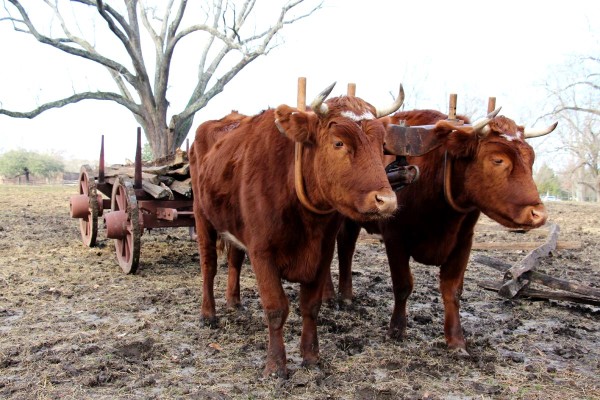 The twins came to us from the Mark Winslow family in Maine. Their farm has been breeding and raising cattle for generations. Pat and Mike are known as Milking Shorthorns and in the 18th century, they would have been referred to as Durhams since they originated in Durham, England. Just like our Devon Milking Cattle, this breed serves three purposes: milk, meat, and muscle power.
The twins came to us from the Mark Winslow family in Maine. Their farm has been breeding and raising cattle for generations. Pat and Mike are known as Milking Shorthorns and in the 18th century, they would have been referred to as Durhams since they originated in Durham, England. Just like our Devon Milking Cattle, this breed serves three purposes: milk, meat, and muscle power.
The brothers are “oxen in training.” Lisa Carpenter says her team will earn its official title after putting in about another year’s worth of work. In the 18th century and in the modern day, working steers (historically also called “draught steers” or a “yoke of steers”) were not called oxen until they reached their full size, usually at the age of four. The three-year-old steer weigh roughly 2,900 pounds between the two of them and can haul two to three times their weight. If they’re using any sort of cart with wheels, that amount goes up even more.
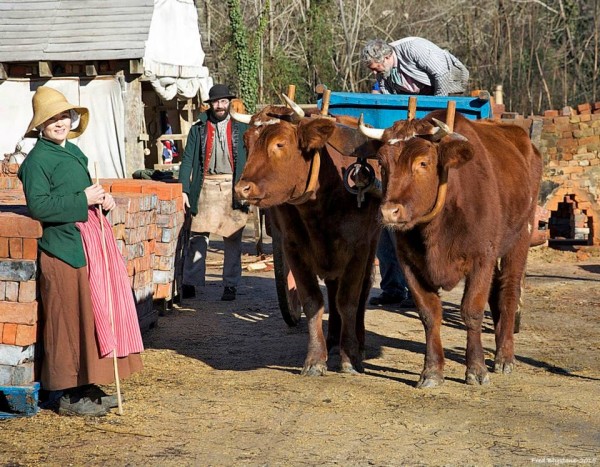 These guys didn’t waste any time getting to work! They’re quickly becoming the “go-to” guys for any of trades that need heavy equipment transported from one spot to another including loads of bricks and barrels. They’ve also been busy hauling lumber, firewood, and hay in around the colonial capital. Come spring, they will join our other teams of oxen to help plow the fields at Great Hopes Plantation.
These guys didn’t waste any time getting to work! They’re quickly becoming the “go-to” guys for any of trades that need heavy equipment transported from one spot to another including loads of bricks and barrels. They’ve also been busy hauling lumber, firewood, and hay in around the colonial capital. Come spring, they will join our other teams of oxen to help plow the fields at Great Hopes Plantation.
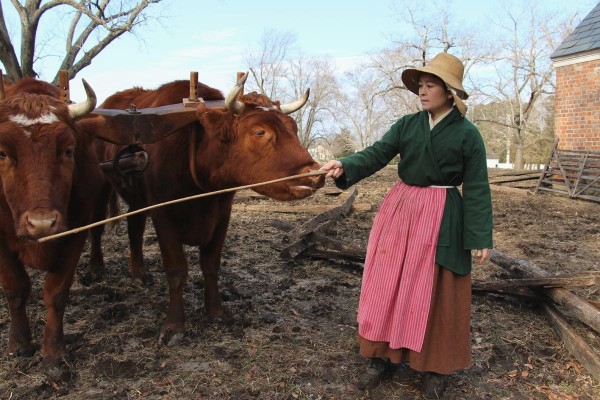 When you see Lisa standing next to the massive animals, you may wonder how she keeps them in line with her tiny “stick.” We learned that stick (officially called a goad) is just as much a visual tool as it is a physical one. The steers are constantly watching to see what she’s doing. That’s precisely why she made a conscious effort to keep from waving it in the air during our interview. She didn’t want to accidentally send the wrong message and confuse them.
When you see Lisa standing next to the massive animals, you may wonder how she keeps them in line with her tiny “stick.” We learned that stick (officially called a goad) is just as much a visual tool as it is a physical one. The steers are constantly watching to see what she’s doing. That’s precisely why she made a conscious effort to keep from waving it in the air during our interview. She didn’t want to accidentally send the wrong message and confuse them.
Lisa also uses her body posture and voice commands to relay her intentions and instructions to the steers. All of her commands are short and sound different from each other so they don’t confuse the animals. “Get Up” means it’s time to go. “Whoa” means stop. “Gee” means move to the right and “Haw” means move to the left. Interestingly, they’re the same commands used for dog sledding team.
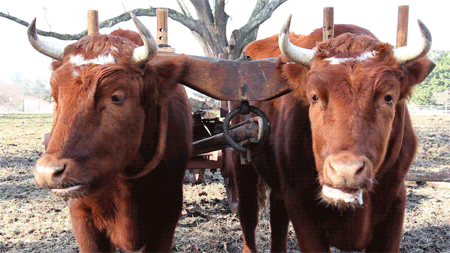
My big question going into an interview about twins: How do you tell them apart? If you stare at these two from the side, it really is tough to do, especially when you factor in their similar mannerisms. Lisa says the best way to identify Mike is to look for a little extra white on his forehead between his eyes and also the white spot peeking through his fur on his left shoulder.
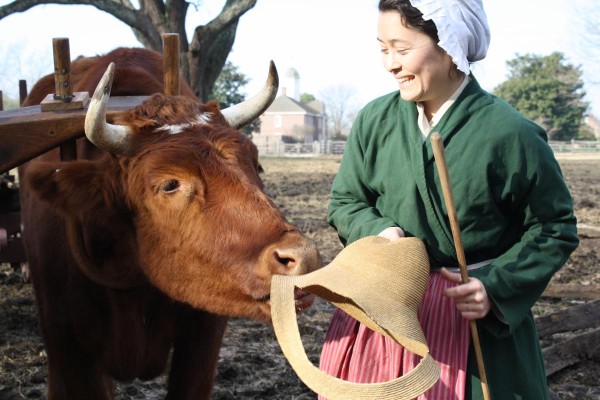 As for their favorite treat, it isn’t food at all. It turns out these guys would prefer a little spa treatment which is why Lisa always brushes them every morning and every evening when she adds or removes the yoke. Oh, and they’re still extremely curious, illustrated by the missing chunk of Lisa’s hat. While we were in the pasture, they even tried to get in another bite!
As for their favorite treat, it isn’t food at all. It turns out these guys would prefer a little spa treatment which is why Lisa always brushes them every morning and every evening when she adds or removes the yoke. Oh, and they’re still extremely curious, illustrated by the missing chunk of Lisa’s hat. While we were in the pasture, they even tried to get in another bite!
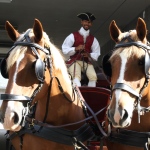
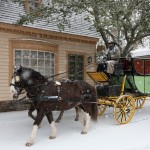

They are two handsome dudes!
I am so happy that Colonial Williamsburg is keeping the Rare Breeds program alive and well!! I so enjoy seeing photos of the animals and reading stories about them and their trainers/handlers!! I was raised on a farm and know the work it takes to keep the animals well and content. When I visit Colonial Williamsburg later this spring, I will look for the new animals - especially Pat and Mike. Thank you for this blog!!
Jan - thank you for your feedback and for taking the time to read our blog. Look for a feature on our lambs, coming soon. They’re due to be born any day now!